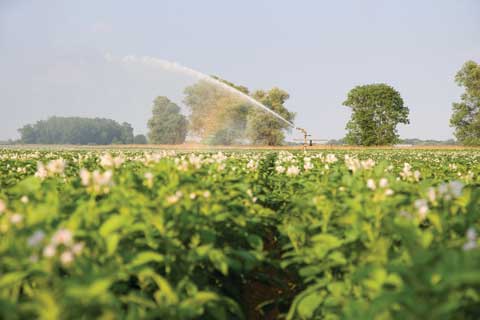Biocontrol agents make their mark

Biological control agents may not be new, but the fact that all the major agchem companies are now taking a serious interest in them is.
Products have been on the market for years, mainly marketed by smaller specialist companies for use in protected crop areas such as glasshouses and, more recently, in the soft fruit and vegetable sector.
Now the multinationals are getting in on the act, which suggests they believe there is a much bigger market out there than is currently being tapped.
There are good reasons why biocontrol agents have remained relatively niche, says BASF’s speciality crops manager Robert Storer.
“It is partly due to the more controlled environmental conditions that facilitate their use. The horticulture sector has also lost many conventional products due to tighter and more expensive legislation, and supermarket protocols are putting pressure on those that remain. As a result we are seeing these products move into the higher-value vegetable sector, too.”
BASF has recently bought the European marketing rights for Serenade from US manufacturer Agraquest. This contains a strain of Bacillus subtilis – just like plenty of other products already on the market. However, there are thousands of strains, and this one – QST 713 – has been specifically selected as a broad-spectrum biofungicide and is Annex 1 listed.
It has also been evaluated by CRD for its label claims, as any conventional chemical would be, unlike other strains sold commercially as growth stimulants, says Mr Storer.
“B subtilis produces lipopeptides, which attack fungal cell membranes. Our strain produces 10-1000 times more lipopeptides than other commercial strains, so it has the potential to be more effective.”
Currently, Serenade is pitched at the horticultural market. However, the potato market is comparable in many respects – many crops end up on the fresh produce shelves of supermarkets, so are subject to the similar supermarket protocols.
“We certainly see potential for Serenade in this market,” says Mr Storer. “It goes back to its ability to deliver low-residue produce as part of an integrated control programme.”
The product attacks a wide range of fungi, including late blight. But the key timing for these types of products has so far been at planting due to ease of application into relatively controlled conditions.
Given that Serenade shows good control of rhizoctonia and common scab, this would seem a most likely entry point for potatoes, Mr Storer notes. “It is widely proven in the USA at this timing as an in-furrow treatment and has also shown good growth-stimulating effects which help yield and grade-out.”
Syngenta could also be set to introduce a novel biological disease control agent, having acquired sole marketing rights in Europe for reysa, an extract of giant knotweed.
The product stimulates the plant’s immune systems to counter infection, explains technical manager Jon Ogborn. Trials across Europe have shown “quite remarkable results”, he notes, including reductions in powdery and downy mildew and botrytis.
Being a natural product, residue studies are not required for approval and a zero harvest interval should be expected, he adds.
However, reysa is aimed primarily at the fruit and vegetable sector – use in broad-acre crops is seemingly much farther off. “Currently, biopesticides are more suited to the fresh produce sector, where the availability of conventional pesticides is often more limited, and they can assist in residue management.
“However, Syngenta will consider biopesticides in broad-acre crops if they can be demonstrated to provide genuine benefits to growers,” says Mr Ogborn.
Andy Barker of Lincolnshire research company Barworth Agriculture believes industry is only scratching the surface. “There is a huge range of actives that is barely tapped. In the next 10-20 years I see many more products coming into the mix.”
The next stage is to improve efficacy, for example using adjuvants to negate UV effects on foliar-applied organisms, or adding minerals or other support species to boost activity and promote persistency, he believes.
Broad-acre crops will be very much part of the market, he adds. “We work closely with grower groups and large farms and are seeing plenty of interest in biologically active agents. Potatoes are the obvious first step, but once we are on farm people want to explore potential in other crops.”
About a third of his work is on potato cyst nematode (PCN), currently majoring on biofumigants. “PCN is a major area and a difficult target. At the moment as an interim strategy we can increase potatoes’ tolerance to PCN, but that leaves a legacy of the pest,” says Dr Barker. “But we are currently working with three or four biologicals that have the potential to replace conventional granular nematicides in the near future.”
Other crops could also benefit before long, he adds. “A European company has been applying a combination of bacteria to commercial oilseed rape crops treated with fungicide and a single application at 3 litres/ha costing from £15/ha boosted oil and yield by an average of 5-8% and 3-10%, respectively.
“No-one is quite sure how it works, but it could be providing additional control of fungi and perhaps bacteria, as well as helping plants to fix nitrogen. It looks very promising.”
Omex Agriculture is in the process of registering “one or two” new products as biopesticides, something it has not had to do before, says business development manager David Booty.
“We now have a range of products under development that will have to be put through the process as they have a direct effect on pests and diseases,” he says. Initial registration will be for fairly high-value fruit and veg crops but there is the potential to go into broad-acre crops like cereals and soya.
First on to the market is likely to be a plant extract, but bacteria-based products are set to follow. Foliar diseases and nematodes are key targets. “I expect to see these products being widely used as part of integrated control programmes within five to 10 years,” Mr Booty predicts.
